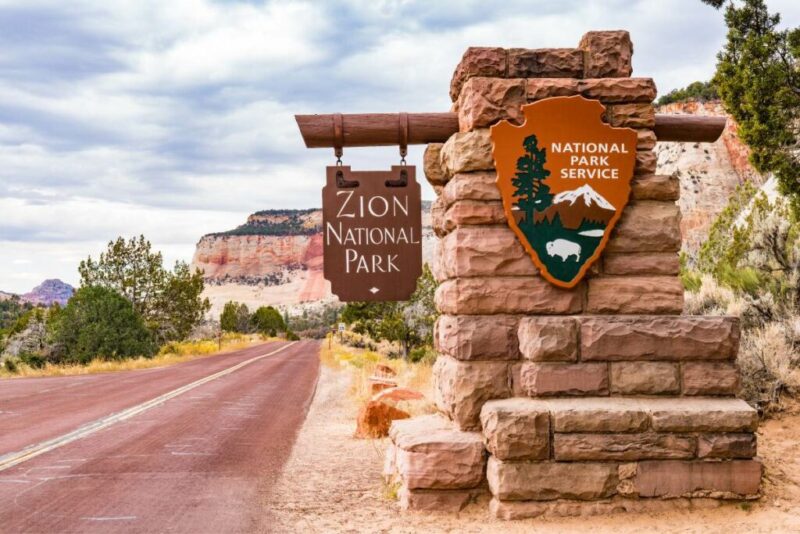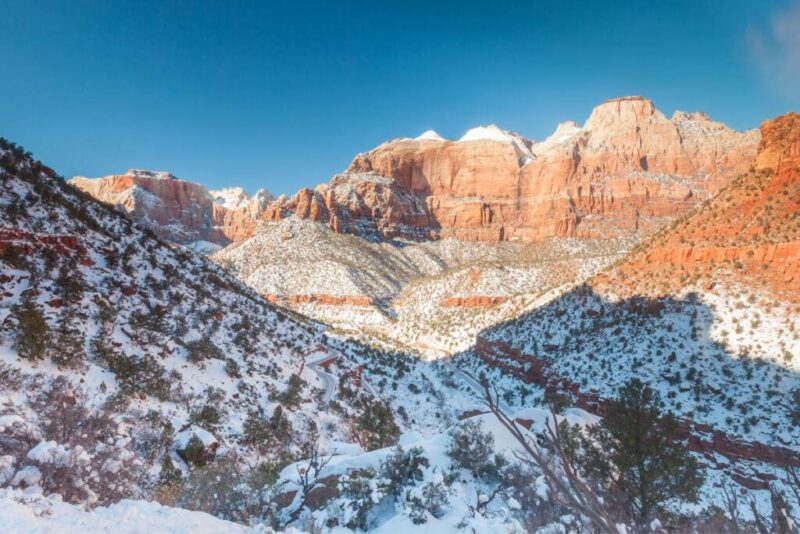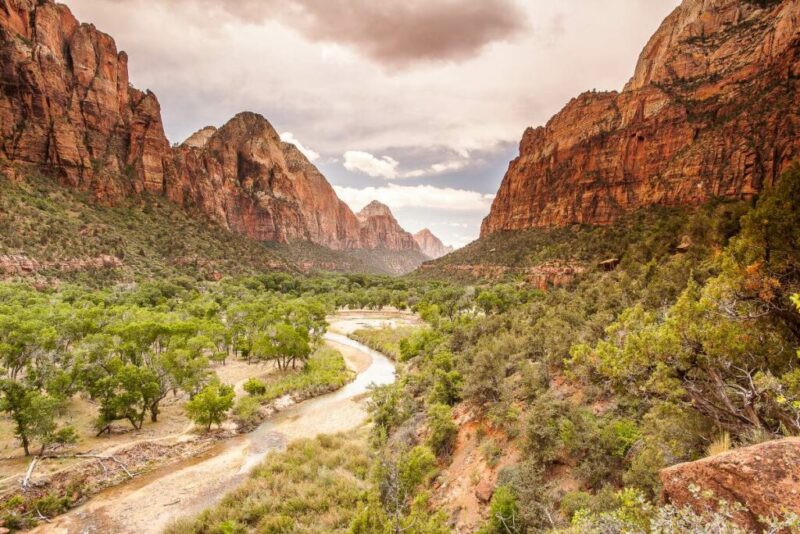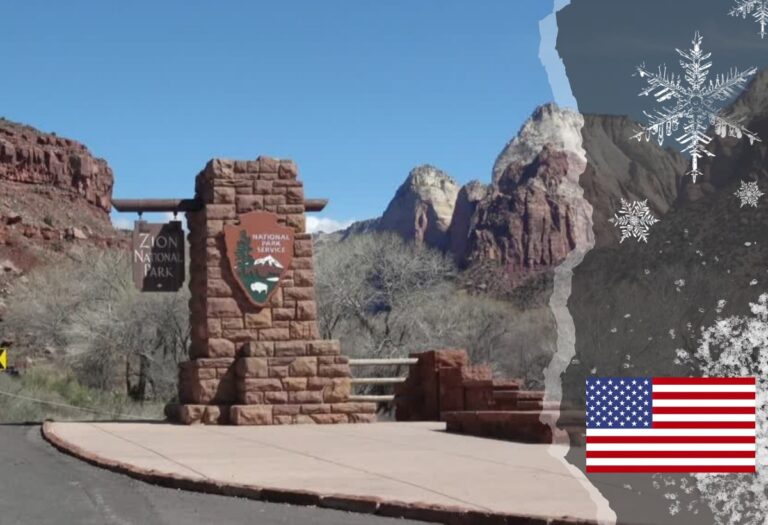Zion National Park is a popular destination for hikers, nature enthusiasts, and outdoor enthusiasts alike. Known for its stunning red rock cliffs, deep canyons, and diverse wildlife, Zion offers something for everyone.
But what about wintertime? Is the park still worth visiting when the temperatures drop and snow begins to fall? In this post, we’ll explore the question on many people’s minds: Does it snow in Zion National Park?
Does It Snow in Zion National Park?

Yes, it can snow in Zion National Park, although snowfall is generally light and infrequent. The park’s elevation ranges from about 3,000 to 8,000 feet above sea level, with the higher elevations experiencing more snowfall.
During the winter, snowfall can occur at the higher elevations of the park, including on the Kolob Terrace and in the Kolob Canyons section of the park, but it is not common. The park does not typically receive large amounts of snowfall, and it does not usually last long on the ground.
However, visitors should be prepared for possible snow and icy conditions during the winter months.
How Often Does It Snow In Zion National Park?
Zion National Park, located in southern Utah, experiences a variety of weather conditions throughout the year. While the park is known for its warm, sunny summers, it can also see snowfall during the winter months. However, the question that many visitors have is, “how often does it snow in Zion National Park?”
The frequency of snowfall in Zion National park varies depending on the elevation. The main canyon and the lower elevations of the park generally see little to no snowfall each year.
However, the higher elevations of the park, such as the Kolob Terrace and the Kolob Canyons section, can see more snowfall. In these areas, it is not uncommon to see a dusting of snow on the ground during the winter months.
The park receives an average of around 30 inches of snowfall per year, with the majority of it falling in January and February. However, it’s worth noting that the park can experience long stretches of dry weather and snowfall is not guaranteed.
Visitors planning a trip to the park during the winter months should be prepared for a range of weather conditions, including the possibility of snow and icy conditions.
In summary, it snows occasionally in Zion National Park, mainly in the higher elevations of the park and the frequency of snowfall varies from year to year.
Visitors should be prepared for a range of weather conditions and check the forecast before planning a trip to the park during the winter months.
When Does it Snow In Zion National Park?

When it comes to snowfall in Zion National Park, the timing can vary from year to year. However, typically the park sees most of its snowfall during the months of December, January and February. The park receives an average of around 30 inches of snowfall per year, with the majority of it falling in these months.
The park’s location in southern Utah, at an elevation between 3,000 to 8,000 feet above sea level, and its unique geography, can create microclimates. This means that different parts of the park can experience different weather conditions at the same time.
Snowfall is more common in the higher elevations of the park, including the Kolob Terrace and the Kolob Canyons section, as opposed to the main canyon and the lower elevations.
It’s worth noting that snowfall in the park is not guaranteed, and it can also happen outside of these months. Visitors planning a trip to the park during the winter months should be prepared for a range of weather conditions, including the possibility of snow and icy conditions.
It’s always a good idea to check the forecast and the park’s website for up-to-date information on weather conditions before planning a trip to the park.
In summary, the park typically sees most of its snowfall in December, January, and February, but it’s not uncommon to see snow outside of these months, particularly in the higher elevations.
Visitors should be prepared for a range of weather conditions and check the forecast before planning a trip to the park during the winter months.
The Weather in Zion National Park, Utah
Zion National Park is located in southern Utah and is known for its warm, sunny summers and mild winters. However, the weather in the park can vary depending on the season and the elevation.
During the summer months, temperatures in the park can reach well into the 90s Fahrenheit (30s Celsius), and it’s not uncommon for the park to experience thunderstorms and flash floods.
It’s important for visitors to be aware of the weather forecast and any potential flash flood warnings when planning a trip to the park during this time.
In the winter, temperatures in the park can drop below freezing, and snowfall is possible, particularly in the higher elevations of the park. While the park does not typically receive large amounts of snowfall, visitors should be prepared for possible snow and icy conditions during the winter months.
The park’s website and the National Weather Service are good resources for checking the current and forecasted weather conditions before planning a trip to the park.
The park’s location and unique geography can also create microclimates, meaning that different parts of the park can experience different weather conditions at the same time.
Overall, visitors should be aware that the weather in Zion National Park can be unpredictable, and it’s always a good idea to check the forecast and come prepared for a range of weather conditions.
Things to Do in Zion National Park in Winter

Winter is a unique and beautiful time to visit Zion National Park. Although the park is known for its warm, sunny summers, the winter months offer a different type of adventure and natural beauty. Here are a few things to do in Zion National Park in winter:
Hiking
Many of the park’s popular trails, such as the Riverside Walk and Angels Landing, are open during the winter and offer a different perspective on the park’s natural beauty. Visitors should be prepared for icy and snowy conditions on the trails and check trail conditions before embarking on a hike.
Snowshoeing and Cross-Country Skiing
The higher elevations of the park, such as the Kolob Terrace and the Kolob Canyons section, are great for snowshoeing and cross-country skiing. Visitors should check trail conditions and bring appropriate gear.
Wildlife Viewing
Winter is a great time for wildlife viewing in the park, as many animals are easier to spot in the absence of foliage and crowds. Keep an eye out for bighorn sheep, mule deer, and other animals that call the park home.
Photography
The park’s natural beauty is on full display in the winter, and the snow adds an extra element of drama to the already stunning landscapes. Visitors can capture some truly unique and beautiful shots during the winter months.
Ranger-Led Programs
The park offers various ranger-led programs such as guided hikes, snowshoe walks, and astronomy talks. These programs are a great way to learn more about the park and its natural and cultural history.
It’s important to note that winter weather conditions can change rapidly in the park, so visitors should be prepared for a range of weather conditions, and check the forecast and trail conditions before planning any activities.
Conclusion
In conclusion, Zion National Park can experience snowfall during the winter months, particularly at the higher elevations of the park such as the Kolob Terrace and the Kolob Canyons section.
However, it’s worth noting that the park does not typically receive large amounts of snowfall, and it does not usually last long on the ground. Visitors planning a trip to the park during the winter months should be prepared for possible snow and icy conditions and check the forecast and the park’s website for up-to-date information on weather conditions before planning a trip.
It’s also important to note that the park’s location and unique geography can create microclimates, meaning that different parts of the park can experience different weather conditions at the same time.
Overall, it’s always a good idea to be prepared for a range of weather conditions when planning a trip to Zion National Park.
Related Articles
- Does It Snow In Utah?
- Does It Snow In Salt Lake City?
- Does It Snow In Arizona?
- Does It Snow In Nevada?
- Does It Snow In Las Vegas?
FAQs About snow in Zion National Park
How Much Snowfall Can I Expect to See in Zion National Park During the Winter?
Are Snowshoes and Cross-Country Skis Available to Rent in the Park?
Is It Safe to Visit the Park in the Winter?
Can I Go on a Backcountry Hike During the Winter Months?
Does It Snow in Zion National Park in December?
December is typically one of the months when the park receives the least amount of snowfall, with most of it falling in January and February.
However, visitors should be prepared for the possibility of snow and icy conditions during their visit.
Does It Snow in Zion National Park in November?
November typically sees less snowfall than December and January, but visitors should still be prepared for the possibility of snow and icy conditions during their visit.
Visitors planning a trip to the park during November should check the forecast and the park’s website for the most up-to-date information on weather conditions before planning a trip.
Related Posts:
- Does It Snow in Athens, Georgia? Witness Rare Winter Magic
- Does It Snow In Tabuk, Saudi Arabia? A Cultural Phenomenon
- Does it Snow in Bangkok? - Exploring the Rare Phenomenon
- Does It Snow In Joshua Tree National Park? Exploring…
- Does It Snow In Yosemite National Park, CA? Discover…
- Does It Snow In Fiji? The Snowfall Enigma







